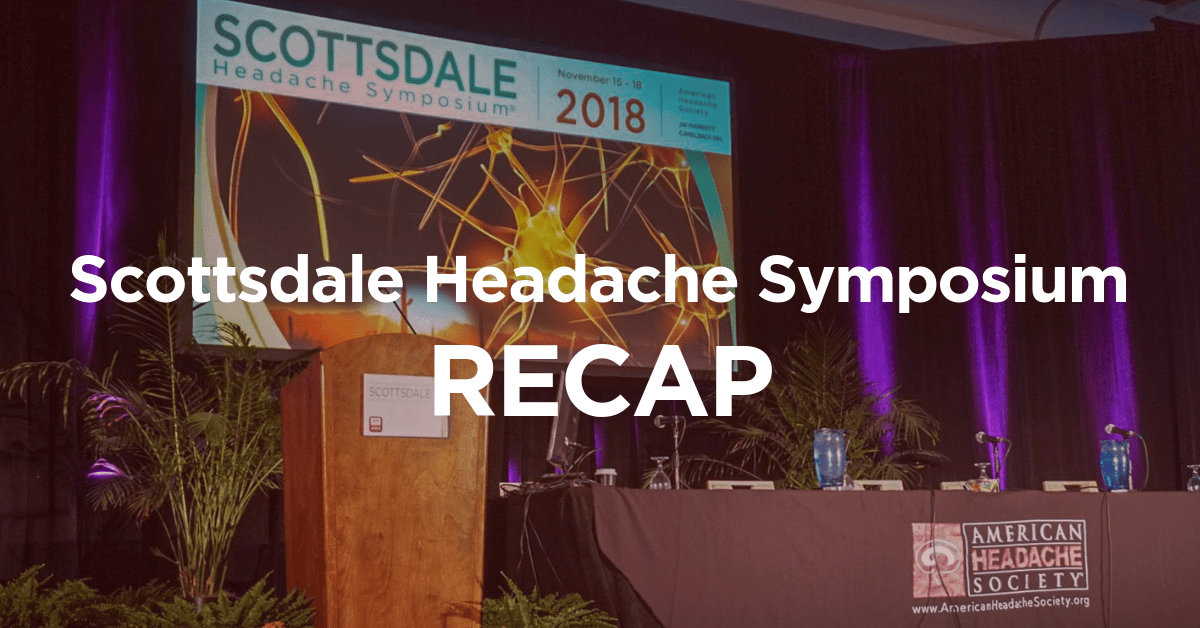
The 2018 Scottsdale Headache Symposium in Review
A recap of the year’s premier educational event in the field of headache medicine
For five days in November, a record 956 healthcare providers and researchers convened in Scottsdale, Arizona, to hear presentations and insights on the latest news and information on headache disorders.
The 2018 Scottsdale Headache Symposium, which took place Nov. 14-18, presented healthcare providers with the latest clinical, evidence-based information on the diagnosis, management and treatment of patients with headache disorders. Attendees heard discussions on a variety of topics, ranging from a plenary session on cutting-edge and emerging treatments to presentations by the “Frontiers in Headache Research” Scholarship Award recipients to the Primary Headache Symposium. There were also many opportunities for attendees to connect with other professionals and researchers in the field.
The symposium began on Wednesday, Nov. 14, starting with an advanced pre-meeting course titled “The Cannabinoids: What Are They,” chaired by Stephen Silberstein, MD, FAHS. The session included six separate presentations by Stephen D. Silberstein, MD, FAHS; Ethan B. Russo, MD; Pal Pacher, MD, PhD; Eric P. Baron, DO; Ken Mackie, MD; Laszlo L. Mechtler, MD; and Peter J. Goadsby, MD, PhD, FAHS. They covered phytocannabinoids, and their effects to a patient’s overall health, including benefits, disadvantages and potential implications of their use.
Additionally, Lynda Krasenbaum, MSN, ANP-BC, co-chaired The Bridge, a comprehensive headache education program designed for nurse practitioners and physician’s assistants involved in the care of patients with headache disorders. The annual program provides practicing NPs and PAs with the latest clinical updates in pediatric and adult headache pathophysiology, diagnosis and treatment.
The Headache 101 is off to a great start. Moderator @RebeccaWellsMD asks the crowd their backgrounds- lots of new attendees to the #AHS18AZ and multidisciplinary practitioners- APPs, PT, Dentists, nutritionists, nurses + MD/DOs. Great industry representation too! @ahsheadache pic.twitter.com/G3xKX16RgQ
— Lauren Doyle Strauss (@StraussHeadache) November 15, 2018
Thursday saw a variety of pre-meeting courses led by the Society’s Special Interest Sections, including “Low CSF Pressure/Volume Headaches” and “Patient Perspective, Updated Clinical Review of Cluster Headaches and TACs with Insights into Future Therapeutic Options.” The Southern Headache Society also hosted a series on “Stroke, Obesity and Leadership in Rural America”; and Rebecca E. Wells, MD, MPH, FAHS, moderated a popular course titled “Headache 101.”
The 2018 Scottsdale Headache Symposium officially began on Friday morning with a welcome address from AHS President Kathleen Digre, MD, FAHS. Following the morning’s opening remarks, Dr. Digre moderated a plenary on “Migraine: What’s New in Diagnosis, Pathophysiology and Prevention,” which included insights from David Dodick, MD, FAHS; Dawn Buse, PhD, FAHS, Peter Goadsby, MD, PhD, FAHS; Christine Lay, MD, FAHS; and Stephanie Nahas, MD, FAHS. The second plenary,
“Trigeminal Autonomic Cephalalgias (TACs), Other Primary Headaches and Secondary CSF and Stroke-related Headaches,” was moderated by Dr. Lay.
We are recognizing Dr. Rafael Benoliel, BDS (Hons) with the prestigious Steven B. Graff-Radford Orofacial Pain and #Headache Lectureship. pic.twitter.com/Ve11gkhclx
— American Headache Society (@ahsheadache) November 16, 2018
On Friday afternoon, Rafael Rafael Benoliel, BDS (Hons), was awarded the prestigious Steven B. Graff-Radford Orofacial Pain and Headache Lectureship; however, due to unforeseen weather conditions, Dr. Benoliel was unable to deliver his lecture. Thomas Ward, MD, FAHS, delivered a discussion on Headache: The Journal of Head and Face Pain, of which he serves as editor. The afternoon’s activities concluded with a plenary on “Behavioral, Complementary and Pediatric Headache Treatment,” which was moderated by R. Allan Purdy, MD, FAHS.
Truly honored and proud to be a member of the @ahsheadache board of directors. Excited for the #TownHall so we can hear from YOU about ways to make the society even better! #AHS18AZ pic.twitter.com/lUwllMNIUb
— Bert Vargas (@BertVargas) November 17, 2018
In the evening, the Society’s various Special Interest Sections gathered for a Special Interest Section Fair, in an effort to gain new members, share future goals and discuss current projects with AHS members. The Society’s Town Hall, which highlighted our growth and achievements in 2018 and our vision for 2019, followed and concluded the day’s activities.
Congratulations to @obegassededhaem on her @ahsheadache scholarship and #migraine & #epilepsy study!
She is a #HeadacheEdu alum and has a wonderful mentor. @MiaMinenMD #AHS18AZ pic.twitter.com/030t5QMSxN— Matthew Robbins, MD (@mrobbinsmd) November 17, 2018
Saturday morning consisted of three separate plenaries on “Cutting Edge and Emerging Treatments,” “Chronic Migraine and Refractory Headache” and “Our “Stars” Pick Top Articles of the Year.” The “Frontiers in Headache Research” Scholarship Award recipients delivered their presentations shortly thereafter—with an introduction by Andrew Charles, MD, FAHS. Olivia Begasse de Dhaem, MD, presented a discussion on “Migraine Comorbidity and Cognitive Performance in Patients with Focal Epilepsy”; and Matthew Burke, MD, discussed “Coordinate-Based Network Mapping of Migraine.” Finally, Jennifer Robblee, MD, MSc, FRCPC, spoke on “TREAT (Triaging Referrals to E-consult Assessment Versus Traditional) Headache Management Quality Improvement Pilot Study.”
Congratulations to the presenters and all of the “Frontiers in Headache Research” Scholarship Award recipients: John Burkett, MD; Claire Ceriani, MD; Arash Danesh, MD; Raquel Fonseca, MD; Joshua Lai, MD; Alina Masters-Israilov, MD; and Brooke Reidy, PhD.
If #migraine doesn't respond to #CGRP antibodies in the first month, should you continue? @petergoadsby says yes! There is promising data for migraine response even at months 2 and 3. Continued efficacy at 1 year. #AHS18AZ pic.twitter.com/XAgtyZsUwI
— Simy K. Parikh (@SimyParikh) November 17, 2018
Saturday afternoon consisted of two concurrent sessions, including Injection Training, Advocacy and the Basic Science of Headache Medicine, as well as Wellness, Women’s Issues and Traumatic Brain Injury.
Case presentations and the Primary Headache Symposium, moderated by Morris Levin, MD, FAHS, kicked off Sunday, the final day of this year’s Symposium. Botox injection training, moderated by Rashmi Halker Singh, MD, FAHS, rounded out the morning’s activities.
Thank you to everyone who attended this year’s Symposium. Your attendance and contributions have helped make this year’s program our best to date. Although the Symposium has ended, you can continue to share your photos, key takeaways and favorite moments by tweeting at us @ahsheadache or using #AHS18AZ.


